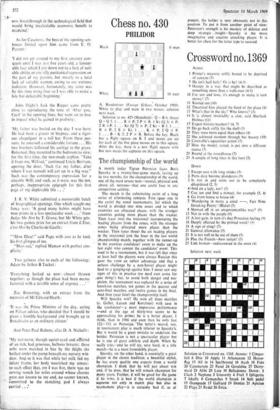Chess no. 430
PHILIDOR
A. Boudantzev (Europe Echecs, October 1968). White to play and mate in two moves; solution next week.
Solution to no. 429 (Mansfield): Q – B 6, threat Q – Q 5. 1 B X P; 2 P x R. 1 Kt (Q 3) x P; 2 B x P. 1 . . . Kt (Q 7) X P; 2 Kt – B 3. 1 . . .
R x P; 2 R x Kt. 1 . K x P; 2 Q x P. 1 . . . B – K 5; 2 P x R. Before the key. Black has a flight -square on K 5 and mates are set for each of the five piece moves on to this square. After the key, there is a new flight square with five new mates for captures on this square.
The championship of the world
A month today Tigran Petrosian faces Boris Spassky in a twenty-four-game match, lasting up to two months, for the championship of the world, one of the most severe tests—mental, physical and. above all, nervous—that one could face in any competitive activity.
The match is the culminating point of a long series of eliminating contests. First (year one in the cycle) the zonal tournaments, for which the world is divided into nine zones and to which countries are allocated places, with the stronger countries getting more places than the weaker. Then (year two) the interzonal incorporating the leading players from the zones, with the stronger zones being allocated more places than the weaker. Then (year three) the six leading players in the interzonal join the loser in the last world championship match, together with the runner-up in the previous candidates' event to make up the last eight who contest the candidates' event. This used to be a tournament, but it was felt that since at least half the players were always Russian this gave the USSR an unfair advantage and that a serious challenge by a non-Soviet player might lead to a ganging-up against him. I never saw any signs of this in practice (no need ever arose for .,one thing!) but, to avoid both danger and sus- picion, the tournament was replaced by a series of knockout matches, ten games in the quarter and semi-final matches, and twelve games in the final. And then (year four) the championship itself.
Will Spassky win? He won all three matches
(v. Geller, Larsen and Korchnoi) with ease in the candidates'—a most impressive performance —and at the age of thirty-two seems to be approaching his prime; he is a better player, I think, than in 1966 and even then he only lost 121-111 to Petrosian. The latter's record, too, in tournament play is much inferior to Spassky's. But it would be a great mistake to underrate the holder. Petrosian is not a spectacular player but he is one of great subtlety and depth. When he really tries—and he will try, very hard, in a title match—he is a most formidable player.
Spassky, on the other hand, is essentially a great player in the classic tradition; a beautiful stylist, he has every quality one expects from a world champion. I think that he will just about win and, if he does, that he will remain champion for many years. Further, it will be good for the game if he wins; it is best if the world champion is supreme not only in match play but also in tournament play—it is certainly bad if, as at present, the holder is very obviously not in this position. To put it from another point of view: Petrosian's strength is his mastery of defence and deep strategic ...insight—Spassky is the more imaginative and creative attacking player. It is better for chess for the latter type to succeed.


































 Previous page
Previous page